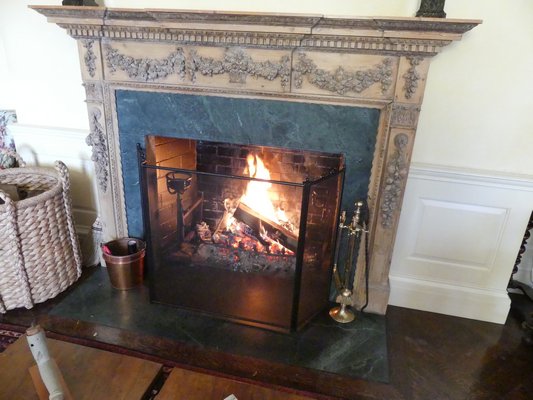

There’s nothing quite like having a fireplace or wood stove, stoking it up on a cold winter day. Sitting near the fire and enjoying the heat, the dancing flames and the primal link that we humans seem to have to a fire. But fireplaces are insanely inefficient and can actually make your house colder even though the radiated heat just in front of the flames feels wonderful. Fireplaces are also terrible when it comes to air pollution and every year they result in fires that damage and destroy homes.
Old-fashioned wood-burning stoves come in second when it comes to being polluters of the air and they too are innately inefficient. In the past 30 years, we’ve been able to buy much cleaner wood-burning stoves that have been far more efficient in their use of wood and in particulate emissions—the stuff that pollutes the air. But there are changes in the wind and, according to recent statistics, wood is now the fastest growing source of heating fuel in the United States.
All well and good, but out here on eastern Long Island we’ve got a bit of a problem. Wood for heating is expensive because we have very limited sources for what’s called cord wood. For years, I was able to heat my Shinnecock Hills home with wood but only because a friend allowed me to harvest wood on his 20 nearby acres and my best friend was an arborist who was more than happy to supply me with wood. But I still had to split and dry it.
But for all practical purposes, a good and reasonably priced supply of firewood is hard to come by out here. It really can’t be legally trucked in from off Long Island, where it’s plentiful, because moving firewood around is now limited to a radius of 50 miles from where it’s harvested in order to control a number of tree-killing invasive insect species. The exception is firewood that has been kiln dried—but that adds substantially to the price.
There are other issues as well. (The good news comes later). Even if you are using your fireplace only three or four times a year, it and your chimney should be inspected annually for damage, debris and obstructions. This should be done by a certified and insured chimney sweep and you should retain the receipt once the work is done. The sweep can clean your flue, brush it if necessary and inspect the interior of the flue for signs of creosote buildup and critters. Squirrels love to build their winter nests in chimneys and if that’s a problem your sweep may be able to add a screen to the chimney top to prevent this kind of entry. Squirrels can also start nest building then abandon the work, leaving behind a nice stash of twigs and leaves that can be one source of a chimney fire.
Also make sure your damper is in good working order. The damper should always be closed until just before you begin your fire and then left open until the coals and ashes are cold. If you’re forgetful about your damper you can buy flags that hang down from the damper handle reminding you that the damper is either open or closed. And as wonderful as that fireplace and fire are, remember that all the air being used for combustion either has to be supplied by air feeds that some fireplaces have on the bottom or sides or the air gets sucked through every nook and cranny in your house—bringing the cold outside air in.
Then there’s the wood. It needs to be split and dry. Firewood should have a moisture content of around 20 percent, and if you’re curious you can buy an inexpensive wood moisture meter at most large hardware and home supply stores. How long does it take to get firewood that dry? If the wood is split and stacked with the top of the pile covered to keep rain and snow from soaking the stack, it can take a year or longer. If you want to build a solar kiln, this can speed up the process to as little as six months. But for all intents and purposes, firewood should be allowed to dry for up to 18 months. Once dry to 20 percent moisture content, the wood can be stored for years and years.
Never store large quantities of firewood in your house or against your house. In the house, the wood can be a source for wood-boring insects. And next to your house, it can do the same as well as attract all sorts of rodents. We store a weekend’s worth of wood on a raised metal wood rack on our back porch, but our main supply is stacked in two 16-foot-long rows about 30 feet from the back door. Wood “rounds,” like a cut tree trunk 24 inches in diameter and 20 or so inches long and not split, will not adequately dry for burning. Rounds larger than 8 inches in diameter will need to be split or they may never truly dry.
There are legal guidelines about how firewood should be sold and while you should know about them, you’ll find little help in making sure the rules are followed. In New York State, firewood in bulk can be sold only by the cord or portion of a cord like a face cord. A cord of wood, stacked, is 4 feet wide, 4 feet tall and 8 feet long, or about 128 cubic feet. A “face” cord is one third of a full cord. Be wary of a dealer who says, “I don’t measure it that way” or “I sell by the truckload.” You should also know if you are getting dry wood or newly split wood that still needs to be dried before you burn it. You can use your wood moisture meter or look at the ends of the pieces of wood. If they have splits and cracked ends, this can be a sign of wood that has had some drying time.
Once the fire is out, your next job is the ashes. If you’re sure the ashes are dead and cold, they can be shoveled into a metal container or ash can for storage or removal. Don’t use your regular household vacuum cleaner as the ash is very fine and will clog the filters or can become airborne. There are shop vacs and specialty vacs that have filters and canisters designed for wood ash and these are the ones to use. There’s no need to throw away the ash. It’s a great fertilizer and can be added to your flower garden, vegetable garden, lawn and compost pile. Some can also be stored and kept dry for slug control next year.
Woods to look for when purchasing firewood are oak, maple, ash and birch, which are all referred to as hardwoods. And if you can score some apple wood, it has a great aroma and burns very hot. Avoid softwoods like pine, larch and cedar, although a small piece of cedar thrown in now and then also adds a nice aroma.
Next week, more ways to heat with wood, some without the need for cord wood and stacks. And wood heat that can be 90 percent efficient, rivaling the best fossil fuel furnaces. There are also new EPA regulations coming into effect in 2020 about wood-burning stoves that you should be aware of. Burn the wood safely, keep the chimney clean and keep growing.
 More Posts from Andrew Messinger
More Posts from Andrew Messinger